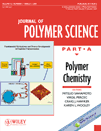Measurement of the dissolved oxygen concentration in acrylate monomers with a novel photochemical method
Abstract
Because of the well-known radical-scavenging behavior, molecular oxygen is capable of inhibiting free-radical chain polymerizations of unsaturated monomers. The deleterious effects of diffused oxygen in a polymerization system result in both a reduced polymerization rate and the loss of surface properties of a polymer film or coating. However, reliable data for oxygen concentration in organic monomers are relatively scarce because of the experimental and instrumental limitations of the commercially available techniques. In this study, a photochemical method was developed and was used to obtain the dissolved oxygen concentration in seven acrylate monomers. The principle of the method was to convert ground-state molecular oxygen dissolved in monomer to the excited, singlet-state oxygen and then react the singlet oxygen with a third compound (singlet oxygen trapper). By monitoring the concentration of this singlet oxygen trapper spectrophotometrically, the concentration of dissolved oxygen can be obtained with the established stoichiometry for the reaction between singlet oxygen and trapper. The singlet oxygen concentrations in the acrylate monomers varied from 0.59 to 2.07 × 10−3 mol/L, depending on the monomer structure. The strategies and considerations for generalizing the method to other systems, including highly oxygenated organics, are discussed. © 2004 Wiley Periodicals, Inc. J Polym Sci Part A: Polym Chem 42: 1285–1292, 2004




